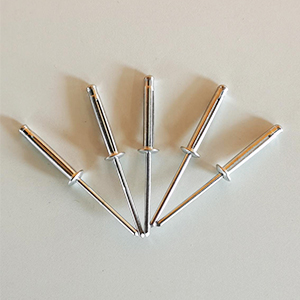Factors to consider when selecting rivets:
•a.Strength required for connection
First, determine the tensile strength and shear strength required by a single rivet at the connection location of the workpiece. The demand for a single product can be calculated based on the total connection strength required by the workpiece and the number of rivets arranged. The diameter of the rivet, the material of the rivet body, And the style of rivets will affect the strength. After the standard is determined, you can select suitable products that meet the standards based on the tensile strength (tensile) and shear strength (shear) columns in the Feikos rivet sample book.
•b. Thickness of the object to be riveted
Measure the total thickness of the workpiece that needs to be riveted. This will determine the "grip value" required for the rivet you choose. Please refer to the information in the "Grip Range" column on the Feikos rivet sample to select a riveting range that covers the thickness of the work. If the rivet specification is insufficient in length, it will not be able to correctly form sufficient blind support on the back of the workpiece, resulting in weak riveting.
•c. Material of the object to be connected
The material of the rivet itself and the material of the workpiece being fixed will affect the connection strength. Generally, the rivet material should have the same or similar physical and mechanical properties as the material of the workpiece being fixed. Because obvious material differences may lead to material fatigue or electrical corrosion. The resulting riveting failure.
•d.Drill size
It is important to match the drill hole size with the rivet size. A hole that is too small will make it difficult to insert the rivet, and a hole that is too large will cause the rivet to be weak or even the rivet to fall off. You can refer to the "Drill Hole Size" on the Feikos rivet sample. Use one column to select the appropriate product or drill hole size. If the size is not standard, please contact our sales engineer for professional advice.
•e. Selection of rivet head type (generally round head, countersunk head, large brim, etc.)
Round head rivets are suitable for most scenarios. However, when soft or fragile materials need to be secured to rigid lining members, large brim rivets, which are larger than round heads, should be considered. Large brim rivets provide 2x the The contact surface of ordinary round heads. If the surface after riveting needs to be flush, you can choose countersunk head rivets to use with countersunk head drilling.

Related News
- Types of wire drawing rivets and anti-rust methods
- What are the functions of rivets?
- How to use blind rivets
- What is a rivet nut?
- Structure introduction and maintenance of rivet gun
- Application of Lantern Rivet Nut
- Classification and application of rivet standoffs
- The working principle and selection rules of riveting gun
- The use of rivet nuts
- Comparison of drawing rivet connection and traditional craftsmanship
- How to install the bolts of the rivet gun
- Introduction to the application and performance of wire drawing rivets
- How to prevent oxidation of rivets
- Characteristics of lantern rivets
- Precautions when using ring groove rivets
- Advantages and precautions of ring groove rivets
- What are the types of rivets?
- Several common riveting guns
- The purpose and working principle of blind rivet nuts
- Features of Seahorse Rivets



